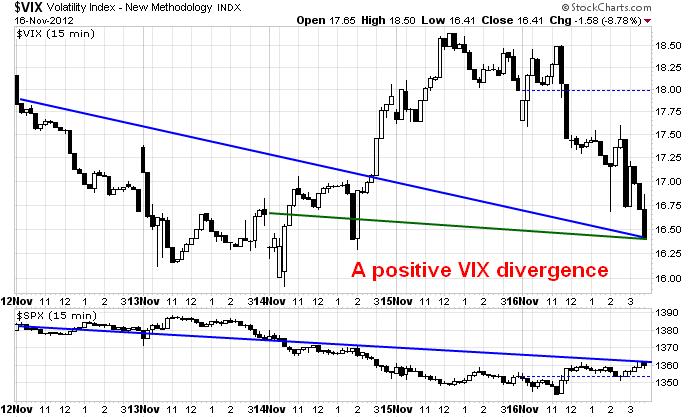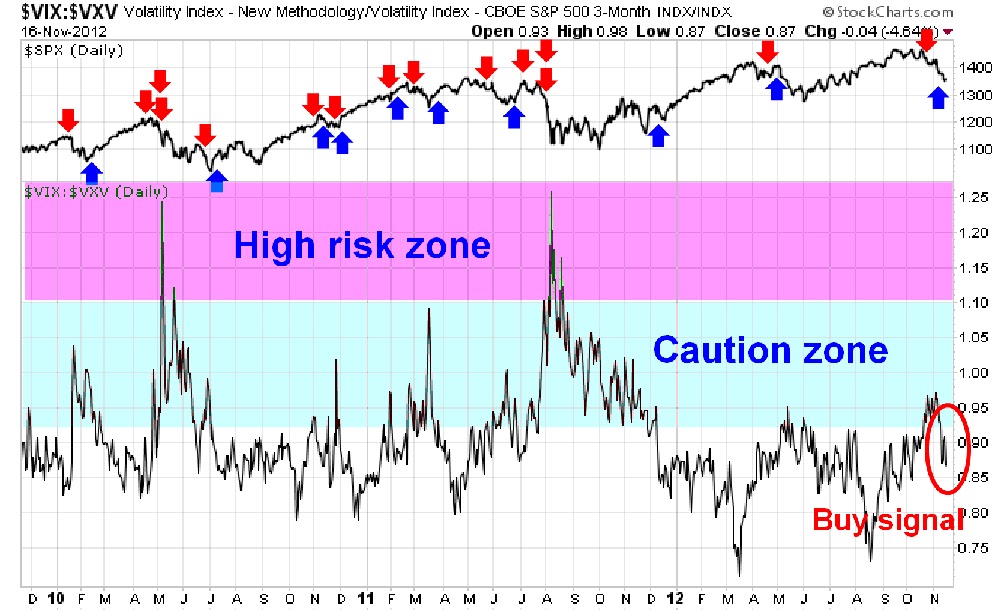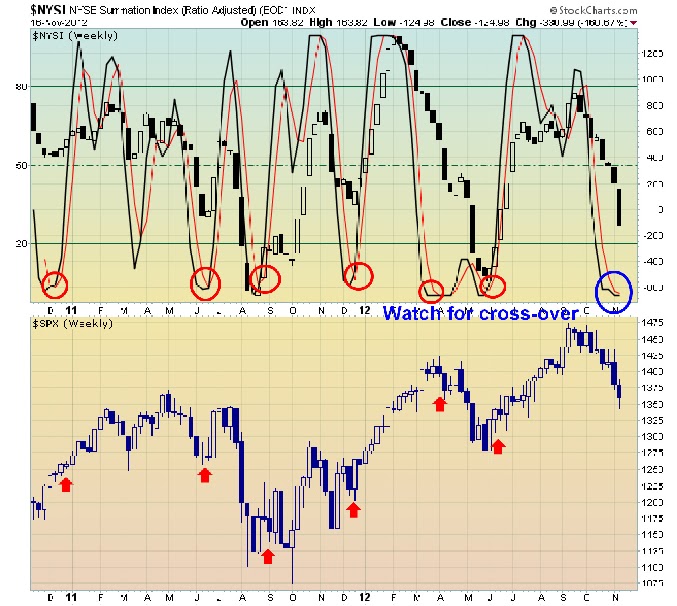In my post last week I noted a number of positive divergences in the FX market (see Waiting for the bounce) and thought that equities were poised for a bounce. Now I am seeing bullish divergences in the VIX Index as well, which suggest that the markets are poised for a more sustainable rally into December much like the traditional Santa Claus rally.
First, consider this chart of the VIX Index (top) and the SPX (bottom). The normal inverse relationship of these two indices appears to be broken. Stocks have been falling all of last week, so why is the VIX down on the week as well? Even if you were to ignore the lockstep downward movement of the VIX and SPX on Monday and Tuesday, the VIX was flat to slightly down from Tuesday's close to Friday (green line) while the stock market continued to fall for that period.
Is fear falling? If so, then is this a bullish divergence?
Volatility term structure forecasting a bullish reversal
In addition, I wrote read interesting post by Vance Harwood entitled Protecting High Yield Bond Investments with VIX/VXV Based Timing where he used the term structure of volatility for market timing (mostly in high yield bonds):
Recently I’ve been looking at volatility metrics for predicting market action. The CBOE’s VIX index gets a lot of attention, but using absolute values of the VIX to trigger investments is almost certainly useless. On the other hand, volatility prices over different time frames, often called the term structure, does show significant predictive value.
In a truly bearish market the short term expected volatility, typically cheaper than longer term volatility, climbs higher than the longer term value. This behavior is shared between flavors of VIX (e.g., the one month VIX and its three month version VXV), VIX futures, and the implied volatility of same strike options of different months...
A simple metric that captures this behavior divides the short term volatility number by a longer term number. If the ratio is below one the market is relatively calm, if above one the market is especially nervous. I’ve been using the CBOE’s VIX and VXV indexes as a convenient way to implement this volatility metric.
The same principles he uses can be applied to the stock market. In "normal" markets, short-term volatility (VIX) is slightly lower than longer dated volatility (e.g. three-month VXV). Harwood uses the VIX to VXV ratio as a way of measuring how much angst the market has about volatility. If one-month volatility (VIX) significantly rises above three-month volatility (VXV), then watch out below.
He uses a threshold of 0.917 for the VIX to VXV as his trigger point. If the ratio is below that number, then he will hold high yield bonds, but he will exit his position if the ratio rises above the threshold.
While the 0.917 threshold is a trigger that could be the result of data mining, I examined the history of ratio based on data I downloaded from CBOE and found the median ratio was 0.928. The difference between Harwood's 0.917 and the median is, as they say, close enough for government work. As a test, I added a further refinement. I created a second "crash warning" trigger, based on the median plus two standard deviations, which came to about 1.10.
The chart below shows the results of my backtest of a modified version of Harwood's model. First consider the lower panel showing the VIX to VXV ratio. I have defined a high-risk zone as ratio readings that are two standard deviations above the median and a caution zone as readings above the median of 0.928. 
Buy signals are generated when the ratio descends from the caution zone below the median ratio reading, which are shown as blue arrows in the upper panel of the S+P 500. Sell signals occur when the ratio rises above the median (red arrows) and "crash warnings" are flashed when the ratio rises above two standard deviations above the median.
As you can see, the model seems to have backtested reasonably well and will bear watching to see how it performs in real-time. Buy signals have been relatively good entry points and sell signals have been good exit points to go to cash. Moreover, the two "crash warnings" have been excellent signals to enter into short positions.
With the caveat that this is only a backtest, I would highlight the back that the VIX to VXV indicator has fallen and generated a buy signal in the last week. Based on past experience, this suggests a sustained advance of several weeks for the stock market.
NYSE Summation Index turning up?
In addition, I have been watching the slow stochastic of the NYSE Summation Index, which is shown below in the top panel, with the SPX shown in the bottom panel. In the past, cross-overs in the stochastic have marked good entry points to get long the stock market and this indicator has only failed once out of six in the past two years. 
In summary, the stock market has fallen hard in the last few weeks and is oversold. While oversold markets can get more oversold, this market is poised for a rally. Intermediate term indicators, such as the VIX Index, the term structure of volatility (which measure risk appetite) and breadth indicators (NYSE Summation Index) are pointing to a multi-week advance once a bottom is established.
Get ready for the Santa Claus rally.
Disclosure: Cam Hui is a portfolio manager at Qwest Investment Fund Management Ltd. ("Qwest"). This article is prepared by Mr. Hui as an outside business activity. As such, Qwest does not review or approve materials presented herein. The opinions and any recommendations expressed in this blog are those of the author and do not reflect the opinions or recommendations of Qwest.
None of the information or opinions expressed in this blog constitutes a solicitation for the purchase or sale of any security or other instrument. Nothing in this article constitutes investment advice and any recommendations that may be contained herein have not been based upon a consideration of the investment objectives, financial situation or particular needs of any specific recipient. Any purchase or sale activity in any securities or other instrument should be based upon your own analysis and conclusions. Past performance is not indicative of future results. Either Qwest or Mr. Hui may hold or control long or short positions in the securities or instruments mentioned.
- English (UK)
- English (India)
- English (Canada)
- English (Australia)
- English (South Africa)
- English (Philippines)
- English (Nigeria)
- Deutsch
- Español (España)
- Español (México)
- Français
- Italiano
- Nederlands
- Português (Portugal)
- Polski
- Português (Brasil)
- Русский
- Türkçe
- العربية
- Ελληνικά
- Svenska
- Suomi
- עברית
- 日本語
- 한국어
- 简体中文
- 繁體中文
- Bahasa Indonesia
- Bahasa Melayu
- ไทย
- Tiếng Việt
- हिंदी
Will We See A Santa Claus Rally?
Published 11/19/2012, 04:34 AM
Updated 07/09/2023, 06:31 AM
Will We See A Santa Claus Rally?
Latest comments
Install Our App
Risk Disclosure: Trading in financial instruments and/or cryptocurrencies involves high risks including the risk of losing some, or all, of your investment amount, and may not be suitable for all investors. Prices of cryptocurrencies are extremely volatile and may be affected by external factors such as financial, regulatory or political events. Trading on margin increases the financial risks.
Before deciding to trade in financial instrument or cryptocurrencies you should be fully informed of the risks and costs associated with trading the financial markets, carefully consider your investment objectives, level of experience, and risk appetite, and seek professional advice where needed.
Fusion Media would like to remind you that the data contained in this website is not necessarily real-time nor accurate. The data and prices on the website are not necessarily provided by any market or exchange, but may be provided by market makers, and so prices may not be accurate and may differ from the actual price at any given market, meaning prices are indicative and not appropriate for trading purposes. Fusion Media and any provider of the data contained in this website will not accept liability for any loss or damage as a result of your trading, or your reliance on the information contained within this website.
It is prohibited to use, store, reproduce, display, modify, transmit or distribute the data contained in this website without the explicit prior written permission of Fusion Media and/or the data provider. All intellectual property rights are reserved by the providers and/or the exchange providing the data contained in this website.
Fusion Media may be compensated by the advertisers that appear on the website, based on your interaction with the advertisements or advertisers.
Before deciding to trade in financial instrument or cryptocurrencies you should be fully informed of the risks and costs associated with trading the financial markets, carefully consider your investment objectives, level of experience, and risk appetite, and seek professional advice where needed.
Fusion Media would like to remind you that the data contained in this website is not necessarily real-time nor accurate. The data and prices on the website are not necessarily provided by any market or exchange, but may be provided by market makers, and so prices may not be accurate and may differ from the actual price at any given market, meaning prices are indicative and not appropriate for trading purposes. Fusion Media and any provider of the data contained in this website will not accept liability for any loss or damage as a result of your trading, or your reliance on the information contained within this website.
It is prohibited to use, store, reproduce, display, modify, transmit or distribute the data contained in this website without the explicit prior written permission of Fusion Media and/or the data provider. All intellectual property rights are reserved by the providers and/or the exchange providing the data contained in this website.
Fusion Media may be compensated by the advertisers that appear on the website, based on your interaction with the advertisements or advertisers.
© 2007-2024 - Fusion Media Limited. All Rights Reserved.
